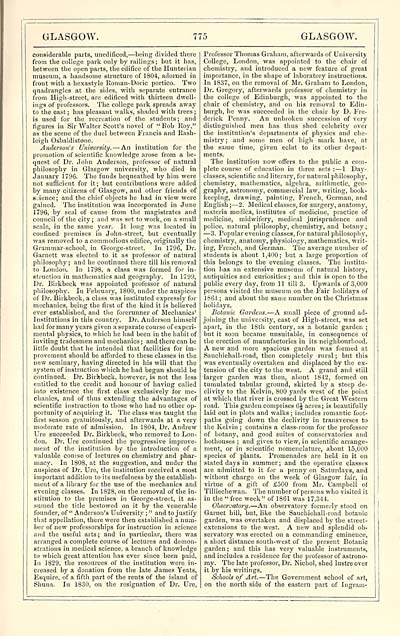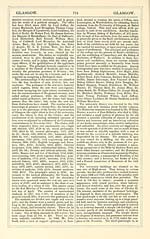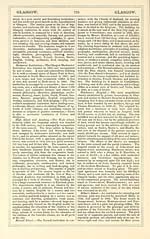Download files
Complete book:
Individual page:
Thumbnail gallery: Grid view | List view

GLASGOW.
775
GLASGOW.
considerable parts, unedificed, — being divided there
from the eollege park only by railings; but it has,
between the open parts, the edifice of the Hunterian
museum, a handsome structure of 1804, adorned in
front with a hexastyle Roman-Doric portico. Two
quadrangles at the sides, with separate entrance
from High-street, are edificed with thirteen dwell-
ings of professors. The college park spreads away
to the east; lias pleasant walks, shaded with trees;
is used for the recreation of the students ; and
figures in Sir Walter Scott's novel of " Bob Roy,"
as the scene of the duel between Francis and Rash-
leigh Osbaldistone.
Anderson's University. — An institution for the
promotion of scientific knowledge arose from a be-
quest of Dr. John Anderson, professor of natural
philosophy in Glasgow university, who died in
January 1796. The funds bequeathed by him were
not sufficient for it; but contributions were added
by many citizens of Glasgow, and other friends of
science; and the chief objects he had in view were
gained. The institution was incorporated in Jnne
1796, by seal of cause from the magistrates and
council of the city ; and was set to work, on a small
scale, in the same year. It long was located in
confined premises in John-street, but eventually
was removed to a commodious edifice, originally the
Grammar-school, in George-street. In 1796, Dr.
Garnett was elected to it as professor of natural
philosophy; and he continued there till his removal
to London. In 1798, a class was formed for in-
struction in mathematics and geography. In 1799,
Dr. Birkbeck was appointed professor of natural
philosophy. In February, 1800, under the auspices
of Dr. Birkbeck, a class was instituted expressly for
mechanics, being the first of the kind it is believed
ever established, and the forerunner of Mechanics'
Institutions in this country. Dr. Anderson himself
had for many years given a separate course of experi-
mental physics, to which he had been in the habit of
inviting tradesmen and mechanics; and there can be
little doubt that he intended that facilities for im-
provement should be afforded to these classes in the
new seminary, having directed in his will that the
system of instruction which he had begun should be
continued. Dr. Birkbeck, however, is not the less
entitled to the credit and honour of having called
into existence the first class exclusively for me-
chanics, and of thus extending the advantages of
scientific instruction to those who had no other op-
portunity of acquiring it. The class was taught the
first season gratuitously, and afterwards at a very
moderate rate of admission. In 1804, Dr. Andrew
Ure succeeded Dr. Birkbeck, who removed to Lon-
don. Dr. Ure continued the progressive improve-
ment of the institution by the introduction of a
valuable course of lectures on chemistry and phar-
macy. In 1808, at the suggestion, and under the
auspices of Dr. Ure, the institution received a most
important addition to its usefulness by the establish-
ment of a library for the use of the mechanics and
evening classes. In 1828, on the removal of the in-
stitution to the premises in George-street, it as-
sumed the title bestowed on it by the venerable
founder, of " Anderson's University ; " and to justify
that appellation, there were then established a num-
ber of new professorships for instruction in science
and the useful arts; and in particular, there was
arranged a complete course of lectures and demon-
strations in medical science, a branch of knowledge
to which great attention has ever since been paid.
In 1829, the resources of the institution were in-
creased by a donation from the late James Yeats,
Esquire, of a fifth part of the rents of the island of
Shuna. In 1830, on the resignation of Dr. Ure,
Professor Thomas Graham, afterwards of University
College, London, was appointed to the chair o(
chemistry, and introduced a new feature of great
importance, in the shape of laboratory instructions.
In 1837, on the removal of Mr. Graham to London,
Dr. Gregory, afterwards professor of chemistry in
the college of Edinburgh, was appointed to the
chair of chemistry, and on bis removal to Edin-
burgh, lie was succeeded in the chair by D. Fre-
derick Penny. An unbroken succession of very
distinguished men lias thus shed celebrity over
the institution's departments of physics and che-
mistry; and some men of high mark have, at
the same time, given eclat to its other depart-
ments.
The institution now offers to the public a com-
plete course of education in three sets : — 1 Day-
classes, scientific and literary, for natural philosophy,
chemistry, mathematics, algebra, arithmetic, geo-
graphy, astronomy, commercial law, writing, book-
keeping, drawing, painting, French, German, and
English ; — 2. Medical classes, for surgery, anatomy,
materia medica, institutes of medicine, practice of
medicine, midwifery, medical jurisprudence and
police, natural philosophy, chemistry, and botany ;
— 3. Popular evening classes, for natural philosophy,
chemistry, anatomy, physiology, mathematics, writ-
ing, French, and German. The average number of
students is about 1,400; but a large proportion of
this belongs to the evening classes. The institu-
tion has an extensive museum of natural history,
antiquities and curiosities ; and this is open to the
public every day, from 11 till 3. Upwards of 3,000
persons visited the museum on the Fair holidays of
1861 ; and about the same number on the Christmas
holidays.
Botanic Gardens. — A small piece of ground ad-
joining the university, east of High-street, was set
apart, in the 18th century, as a botanic garden ;
but it soon became unsuitable, in consequence of
the erection of manufactories in its neighbourhood.
A new and more spacious garden was formed at
Sauchiehall-road, then completely rural ; but this
was eventually overtaken and displaced by the ex-
tension of the city to the west. A grand and still
larger garden was then, about 1842, formed on
tumulated tabular ground, skirted by a steep de-
clivity to the Kelvin, 800 yards west of the point
at which that river is crossed by the Great Western
road. This garden comprises 6J acres; is beautifully
laid out in plots and walks ; includes romantic foot-
paths going down the declivity in transverses to
the Kelvin ; contains a class-room for the professor
of botany, and good suites of conservatories and
hothouses ; and gives to view, in scientific arrange-
ment, or in scientific nomenclature, about 15,000
species of plants. Promenades are held in it on
stated days in summer ; and the operative classes
are admitted to it for a penny on Saturdays, and
without charge on the week of Glasgow fair, in
virtue of a gift of £500 from Mr. Campbell of
Tilliechewan. The number of persons who visited it
in the " free week" of 1861 was 17,344.
Observatory. — An observatory formerly stood on
Garnet hill, but, like the Sauchiehall-road botanic
garden, was overtaken and displaced by the street-
extensions to the west. A new and splendid ob-
servatory was erected on a commanding eminence,
a short distance south-west of the present Botanic
garden; and this has very valuable instruments,
and includes a residence for the professor of astrono-
my. The late professor, Dr. Nicliol, shed lustre over
it by his writings.
Schools of Art. — The Government school of art,
on the north side of the eastern part of Ingram-
775
GLASGOW.
considerable parts, unedificed, — being divided there
from the eollege park only by railings; but it has,
between the open parts, the edifice of the Hunterian
museum, a handsome structure of 1804, adorned in
front with a hexastyle Roman-Doric portico. Two
quadrangles at the sides, with separate entrance
from High-street, are edificed with thirteen dwell-
ings of professors. The college park spreads away
to the east; lias pleasant walks, shaded with trees;
is used for the recreation of the students ; and
figures in Sir Walter Scott's novel of " Bob Roy,"
as the scene of the duel between Francis and Rash-
leigh Osbaldistone.
Anderson's University. — An institution for the
promotion of scientific knowledge arose from a be-
quest of Dr. John Anderson, professor of natural
philosophy in Glasgow university, who died in
January 1796. The funds bequeathed by him were
not sufficient for it; but contributions were added
by many citizens of Glasgow, and other friends of
science; and the chief objects he had in view were
gained. The institution was incorporated in Jnne
1796, by seal of cause from the magistrates and
council of the city ; and was set to work, on a small
scale, in the same year. It long was located in
confined premises in John-street, but eventually
was removed to a commodious edifice, originally the
Grammar-school, in George-street. In 1796, Dr.
Garnett was elected to it as professor of natural
philosophy; and he continued there till his removal
to London. In 1798, a class was formed for in-
struction in mathematics and geography. In 1799,
Dr. Birkbeck was appointed professor of natural
philosophy. In February, 1800, under the auspices
of Dr. Birkbeck, a class was instituted expressly for
mechanics, being the first of the kind it is believed
ever established, and the forerunner of Mechanics'
Institutions in this country. Dr. Anderson himself
had for many years given a separate course of experi-
mental physics, to which he had been in the habit of
inviting tradesmen and mechanics; and there can be
little doubt that he intended that facilities for im-
provement should be afforded to these classes in the
new seminary, having directed in his will that the
system of instruction which he had begun should be
continued. Dr. Birkbeck, however, is not the less
entitled to the credit and honour of having called
into existence the first class exclusively for me-
chanics, and of thus extending the advantages of
scientific instruction to those who had no other op-
portunity of acquiring it. The class was taught the
first season gratuitously, and afterwards at a very
moderate rate of admission. In 1804, Dr. Andrew
Ure succeeded Dr. Birkbeck, who removed to Lon-
don. Dr. Ure continued the progressive improve-
ment of the institution by the introduction of a
valuable course of lectures on chemistry and phar-
macy. In 1808, at the suggestion, and under the
auspices of Dr. Ure, the institution received a most
important addition to its usefulness by the establish-
ment of a library for the use of the mechanics and
evening classes. In 1828, on the removal of the in-
stitution to the premises in George-street, it as-
sumed the title bestowed on it by the venerable
founder, of " Anderson's University ; " and to justify
that appellation, there were then established a num-
ber of new professorships for instruction in science
and the useful arts; and in particular, there was
arranged a complete course of lectures and demon-
strations in medical science, a branch of knowledge
to which great attention has ever since been paid.
In 1829, the resources of the institution were in-
creased by a donation from the late James Yeats,
Esquire, of a fifth part of the rents of the island of
Shuna. In 1830, on the resignation of Dr. Ure,
Professor Thomas Graham, afterwards of University
College, London, was appointed to the chair o(
chemistry, and introduced a new feature of great
importance, in the shape of laboratory instructions.
In 1837, on the removal of Mr. Graham to London,
Dr. Gregory, afterwards professor of chemistry in
the college of Edinburgh, was appointed to the
chair of chemistry, and on bis removal to Edin-
burgh, lie was succeeded in the chair by D. Fre-
derick Penny. An unbroken succession of very
distinguished men lias thus shed celebrity over
the institution's departments of physics and che-
mistry; and some men of high mark have, at
the same time, given eclat to its other depart-
ments.
The institution now offers to the public a com-
plete course of education in three sets : — 1 Day-
classes, scientific and literary, for natural philosophy,
chemistry, mathematics, algebra, arithmetic, geo-
graphy, astronomy, commercial law, writing, book-
keeping, drawing, painting, French, German, and
English ; — 2. Medical classes, for surgery, anatomy,
materia medica, institutes of medicine, practice of
medicine, midwifery, medical jurisprudence and
police, natural philosophy, chemistry, and botany ;
— 3. Popular evening classes, for natural philosophy,
chemistry, anatomy, physiology, mathematics, writ-
ing, French, and German. The average number of
students is about 1,400; but a large proportion of
this belongs to the evening classes. The institu-
tion has an extensive museum of natural history,
antiquities and curiosities ; and this is open to the
public every day, from 11 till 3. Upwards of 3,000
persons visited the museum on the Fair holidays of
1861 ; and about the same number on the Christmas
holidays.
Botanic Gardens. — A small piece of ground ad-
joining the university, east of High-street, was set
apart, in the 18th century, as a botanic garden ;
but it soon became unsuitable, in consequence of
the erection of manufactories in its neighbourhood.
A new and more spacious garden was formed at
Sauchiehall-road, then completely rural ; but this
was eventually overtaken and displaced by the ex-
tension of the city to the west. A grand and still
larger garden was then, about 1842, formed on
tumulated tabular ground, skirted by a steep de-
clivity to the Kelvin, 800 yards west of the point
at which that river is crossed by the Great Western
road. This garden comprises 6J acres; is beautifully
laid out in plots and walks ; includes romantic foot-
paths going down the declivity in transverses to
the Kelvin ; contains a class-room for the professor
of botany, and good suites of conservatories and
hothouses ; and gives to view, in scientific arrange-
ment, or in scientific nomenclature, about 15,000
species of plants. Promenades are held in it on
stated days in summer ; and the operative classes
are admitted to it for a penny on Saturdays, and
without charge on the week of Glasgow fair, in
virtue of a gift of £500 from Mr. Campbell of
Tilliechewan. The number of persons who visited it
in the " free week" of 1861 was 17,344.
Observatory. — An observatory formerly stood on
Garnet hill, but, like the Sauchiehall-road botanic
garden, was overtaken and displaced by the street-
extensions to the west. A new and splendid ob-
servatory was erected on a commanding eminence,
a short distance south-west of the present Botanic
garden; and this has very valuable instruments,
and includes a residence for the professor of astrono-
my. The late professor, Dr. Nicliol, shed lustre over
it by his writings.
Schools of Art. — The Government school of art,
on the north side of the eastern part of Ingram-
Set display mode to: Large image | Transcription
Images and transcriptions on this page, including medium image downloads, may be used under the Creative Commons Attribution 4.0 International Licence unless otherwise stated. ![]()
| Gazetteers of Scotland, 1803-1901 > Imperial gazeteer of Scotland, or, Dictionary of Scottish topography > Volume 1 > (913) Page 775 |
|---|
| Permanent URL | https://digital.nls.uk/97470086 |
|---|
| Description | Volume I: Aan-Gordon. |
|---|---|
| Attribution and copyright: |
|

